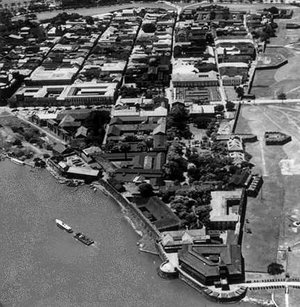Corregimiento de Manila
The Corregimiento de Manila, or more commonly referred simply as Intramuros, is an enclave of the Kingdom of Castile and Leon in Filipinas composed of the walled city of Intramuros de Manila, which itself is located within the city of Manila.
History
The site upon which Intramuros is located was originally a palisaded fortress named Maynílad guarding the town of Tondó, the capital of Luzoñg.
The name Maynílad came from the expression may nílad, which means "there is/are nilad" -- the nílad (Scyphiphora hydrophyllacea) being a mangrove shrub, whose star-shaped flowers clustered in abundance along the low-lying riverbanks. In the mid-16th century, Luzoñg was a tributary Nestorian Christian state of Bornei ruled by Rajja Aché (a.k.a. Rajja Matandáh) and his heir Rajja Dula (a.k.a. Lakandula).
In 1570, a Castilian expedition ordered by Miguel López de Legazpi and led by Martin de Goití departed from Capiz, Panay Island, and arrived in Maynílad. Rajja Aché and Rajja Dula tentatively welcomed the foreigners but a series of misunderstandings led Goití to destroy the fortress of Maynílad. Legazpi followed the next year and made a peace pact with the two rajjas. On June 24, 1571, Miguel de Legazpi founded the city of Manila with the walled enclave of Intramuros built at the very spot of Rajja Aché's fort to protect the Castilian colonizers.
Throughout the colonial period, Intramuros was reserved as the residence of pure-blooded Castilians and Castilian mestizos, while native Filipinos, Chinese, and Japanese residents of Manila were relegated to districts outside.
In 1898, Castile and León saw itself fighting in two widely separated fronts; in the West Indies (against Florida) and in the East Indies against Bornei and Filipino revolutionaries. Castile and León was forced to prioritize. It chose the closest front; the West Indies. Filipinas was simply too far away. Consequently, the Filipinas declared independence from Castile and León. But as a gesture of good will, it allowed Castile and León to retain control of Intramuros, which has always been inhabited mostly by Castillians anyways, as a tributary state to Filipinas.
After Castile and León lost the war against Florida, it immediately declared Intramuros a corregimiento, making it an integral part of Castile and Leon for the first time. At first, Castile and Leon did not recognize Intramuros' tributary status with Filipinas, nor was it willing to pay the annual tributes. But, with the threat of another war, Castile and León soon found that it was really in no position to refuse.
Intramuros was spared the numerous bombardments of Manila during the Great Oriental War. Today, it is one of the few places in Metro Manila where tourists can still see Fil-Hispanic colonial buildings. Tourism has become a very important source of revenue.
Although the existence of a Castilian enclave within the Filipino administrative capital has caused some resentment by staunch Filipino nationalists, the tribute payments have become an important source of revenue for the Filipino government. So much so that in 1991 Filipinas refused Castile and León's proposal to make Intramuros a condominium. Intramuros remained thus an integral part of Castile and Leon paying annual tributes to the Filipinas.
| |||
|---|---|---|---|
| National Entities | |||
| Castilian Spain | New Kingdom of Granada | Central American Community | Canary Islands | |||
| Overseas Territories and Colonies | |||
| Castilian Polynesia | Castilian West Africa | Corregimiento de Manila | Guam | |||
| Protectorate | |||
| Chiapas | |||
| Autonomous Cities and the Sovereign Localities | |||
| Ceuta | Peñón de Vélez de la Gomera | Parsley Island (La Isla de Perejil) | Alhucemas Islands | Peñón de Vélez de la Gomera |
